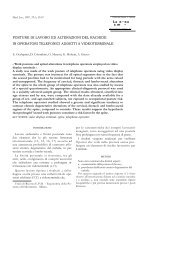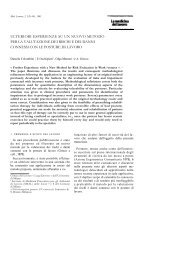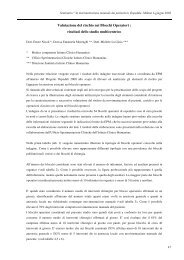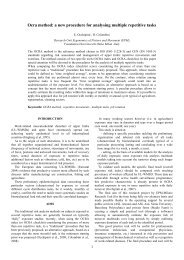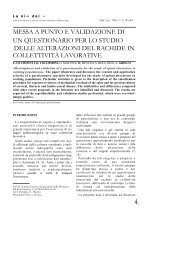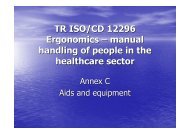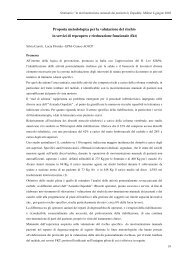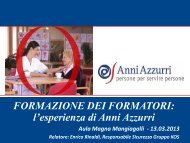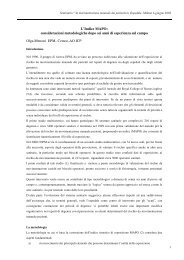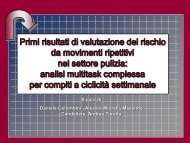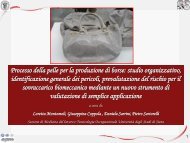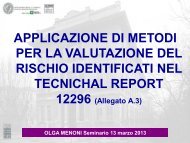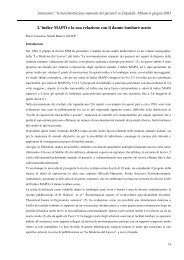Muscular effort and musculo-skeletal disorders in piano students - epm
Muscular effort and musculo-skeletal disorders in piano students - epm
Muscular effort and musculo-skeletal disorders in piano students - epm
You also want an ePaper? Increase the reach of your titles
YUMPU automatically turns print PDFs into web optimized ePapers that Google loves.
ERGONOMICS, 1989, VOL. 32, No. 7, 697-716<strong>Muscular</strong> <strong>effort</strong> <strong>and</strong> <strong>musculo</strong>-<strong>skeletal</strong> <strong>disorders</strong> <strong>in</strong> <strong>piano</strong> <strong>students</strong>:electromyographic, cl<strong>in</strong>ical <strong>and</strong> preventive aspectsA. GRIECO, E. OCCHIPINTi, D. COLOMBINI, O. MENONI,M. BULGHERONI, C. FRIGO <strong>and</strong> S. BOCCARDI`Ergonomics of Posture <strong>and</strong> Movement'—EPM—Research Unit,c/o Cl<strong>in</strong>ica del Lavoro 'Luigi Devoto', Via San Barnaba 8,20122 Milano, ItalyKeywords: Musculo-<strong>skeletal</strong> <strong>disorders</strong>; Piano players; Electromyography; Physicaleducation; Tra<strong>in</strong><strong>in</strong>g.An <strong>in</strong>vestigation was made on the relationship between music practice <strong>and</strong><strong>musculo</strong>-<strong>skeletal</strong> <strong>disorders</strong> among <strong>piano</strong> <strong>students</strong>, with the ma<strong>in</strong> aim of develop<strong>in</strong>ghealth education programmes that would improve the performance <strong>and</strong> health ofthe <strong>students</strong>.The <strong>in</strong>vestigation covered three areas:(a) Analysis of study organization <strong>and</strong> ma<strong>in</strong> <strong>musculo</strong>-<strong>skeletal</strong> compla<strong>in</strong>tsachieved by a questionnaire distributed to ali <strong>piano</strong> <strong>students</strong> at the MilanConservatory.(b) Vocational electromyographic analysis of the <strong>effort</strong> exerted by the variousmuscle groups of the trunk, of the shoulder <strong>and</strong> shoulder biade girdle, <strong>and</strong> ofthe arra dur<strong>in</strong>g performance of a st<strong>and</strong>ard set of <strong>piano</strong> exercises, an unseenpassage <strong>and</strong> a passage of maximum difficulty. This analysis was made on asample of six subjects.(c) A series of preventive measures was developed on the basis of a criticaiassessment of the results (38% of the <strong>students</strong> practised for excessively longperiods without breaks; 62% had from 1 to 5 compla<strong>in</strong>ts, the most affectedsites be<strong>in</strong>g the sp<strong>in</strong>e <strong>and</strong> the trapezius muscles). These consisted largely of ahealth education programma aimed at help<strong>in</strong>g the <strong>students</strong> to suitablyorganze practice <strong>and</strong> resi periods <strong>and</strong> <strong>in</strong> <strong>in</strong>struct<strong>in</strong>g them <strong>in</strong> appropriateexercises for relaxation <strong>and</strong> stretch<strong>in</strong>g of overused muscle groups <strong>and</strong>strengthen<strong>in</strong>g the support<strong>in</strong>g muscle groups. Changes <strong>in</strong> lifestyle avere alsosuggested.L IntroductionRecent literature is poorly lack<strong>in</strong>g <strong>in</strong> data on osteo-muscular <strong>disorders</strong> among pianista.The alterations most frequently attributed to <strong>piano</strong> practice are tend<strong>in</strong>itis of the h<strong>and</strong><strong>and</strong> forearm muscles <strong>and</strong> nerve compression which often manifests as a carpal tunnelsyndrome (Clark 1986).Paradoxically, the most detailed literature on the subject goes back to the lastcentury, with a description of `pianist's cramp' that was identical to the perhaps batterknown writer's <strong>and</strong> telegrapher's cramp. At that time, the condition was the subject ofampie discussion as to its etiopathogenesis <strong>and</strong> cl<strong>in</strong>ical def<strong>in</strong>ition which can <strong>in</strong> eachcase be identified as orig<strong>in</strong>at<strong>in</strong>g from overuse of the <strong>musculo</strong>-tend<strong>in</strong>eous structures ofthe forearm <strong>and</strong> h<strong>and</strong>, which manifests, usually <strong>in</strong> an acute or recurrent forra, with pa<strong>in</strong>,weakness <strong>and</strong> loss of co-ord<strong>in</strong>ation <strong>and</strong> control (up to a transitory paretic-likecondition), accompanied <strong>in</strong> some casca by excessive locai sweat<strong>in</strong>g.0014-0139/89 $3 . 00 (0 1989 Taylor & Francia Ltd.
71 698 A. Grieco et al.PIOn the basis of these bibliographic references of 100 years ago, Australian authorsrecognized the close similarities between pianist's cramp <strong>and</strong> the `overuse syndrome'def<strong>in</strong>ed as `those changes brought about <strong>in</strong> the muscles <strong>and</strong> jo<strong>in</strong>t ligaments fromexcessive use, caus<strong>in</strong>g pa<strong>in</strong>, loss of function, <strong>and</strong> almost always demonstrabletenderness <strong>in</strong> the affected structures'. (Fry 1986, 1987).In a study made <strong>in</strong> seven of Australia's 11 music schools, cover<strong>in</strong>g 409 <strong>piano</strong><strong>students</strong>, it was found that 9% of the <strong>students</strong> were affected by the overuse syndrome to amore or less marked degree. The syndrome was much more frequent <strong>in</strong> females (7%) than<strong>in</strong> males (2%). The saure author reported that the overuse syndrome affects morethan 50% of the musicians <strong>in</strong> modern Symphony orchestrar <strong>in</strong> Australia.There has been a tendency to dem<strong>and</strong> <strong>in</strong>creas<strong>in</strong>g technical performance frommodern concert <strong>piano</strong>s. The Grober concert <strong>piano</strong> of the early 19th century <strong>in</strong>volvedabout 6 mm travel of the key <strong>and</strong> required a force of about 23 g to depress the key, with atension of the middle str<strong>in</strong>g section of 12 to 15 kg, whereas the modern Ste<strong>in</strong>way<strong>in</strong>volver about 10 . 5 mm travel, a depression pressure of about 50 to 60 g <strong>and</strong> 90 kgtension (Fry 1986).On the basis of these observations, we undertook an <strong>in</strong>vestigation which had thefollow<strong>in</strong>g aims:1. Estimate the frequency of <strong>disorders</strong> of the locomotor apparatus <strong>in</strong> <strong>piano</strong><strong>students</strong> of the Milan Conservatory.2. Assess the <strong>effort</strong> of various muscle groups dur<strong>in</strong>g <strong>piano</strong> practice by means ofvocational electromiography techniques, <strong>and</strong> also o utl<strong>in</strong>e a mode) fororganization of practice dur<strong>in</strong>g the week.3. Identify prevention measures, with particular emphasis on ways to change<strong>students</strong>' <strong>in</strong>dividua) attitudes <strong>and</strong> tra<strong>in</strong> them <strong>in</strong> suitable mobilization, relaxation<strong>and</strong> stretch<strong>in</strong>g exercises.2. Methods2.1. Analysis of study day organization <strong>and</strong> analysis of <strong>musculo</strong>-<strong>skeletal</strong> <strong>disorders</strong>A specially developed questionnaire was used, divided f<strong>in</strong>to three parts, i.e.:(a) generai <strong>in</strong>formation <strong>and</strong> features of organization of study <strong>and</strong> free time;(b) occurrence, site, <strong>and</strong> characteristics of any <strong>musculo</strong>-<strong>skeletal</strong> <strong>disorders</strong>;(c) occurrence of psychic, respiratory or digestive compla<strong>in</strong>ts.A total of 117 completed questionnaires were collected (54 males <strong>and</strong> 63 females),equivalent to a response rate of about 75% of the <strong>students</strong> contacted. The compositionof the respondents, by age class, is shown <strong>in</strong> table I.2.2. Electromyographic study2.2.1. subjects: The electromyographic study covered six <strong>piano</strong> <strong>students</strong> (three males<strong>and</strong> three females) enrolled for the f<strong>in</strong>a) years of the course. The subjects participated <strong>in</strong>the experiment voluntarily. Generai anthropometric parameters (weight, height) weremeasured for all subjects, plus a number of specific parameters of the h<strong>and</strong> such asbreadth, length of the third f<strong>in</strong>ger, length of the h<strong>and</strong> at the third f<strong>in</strong>ger, angles betweenf<strong>in</strong>gers at maximum aperture. The relative percentile was calculated for all parameters.2.2.2. Selected <strong>piano</strong> exercises: In order to st<strong>and</strong>ardize the exercises performed by thesix subjects, a set of st<strong>and</strong>ard exercises of vary<strong>in</strong>g difficulty was selected, each <strong>in</strong>volv<strong>in</strong>g
<strong>Muscular</strong> <strong>effort</strong> <strong>and</strong> <strong>musculo</strong>-<strong>skeletal</strong> <strong>disorders</strong> <strong>in</strong> <strong>piano</strong> <strong>students</strong> 699Table I. Distribution of <strong>piano</strong> <strong>students</strong> exam<strong>in</strong>ed via questionnaire, by age class <strong>and</strong> years ofstudy.Age classyearsNumberYears of studySC8-10 9 211-13 26 3.914-16 29 6.117-19 21 9.2620-22 20 11.223-25 8 10.8>25 4 16.5Total number of subject exam<strong>in</strong>ed N=117.a different use of the h<strong>and</strong>/forearm system. The exercises were taken from Hanon (aclassic volume of preparatory exercises widely used <strong>in</strong> <strong>piano</strong> teach<strong>in</strong>g) <strong>and</strong> wereclassified <strong>in</strong> groups accord<strong>in</strong>g to the different aspects of muscular <strong>effort</strong> (figure 1). Eachexercise was performed at two speeds: (a) the m<strong>in</strong>imum speed for the score; (b) thestudent's maximum possible speed. Also, each subject performed an unseen passage(Scott Jopl<strong>in</strong>'s 'Elite Syncopation') which was played aga<strong>in</strong> after 15 m<strong>in</strong> practice.Each student then performed one or two passages from his/her repertoire whichhe/she considered to be the most difficult. Here, it was obviously not possible tost<strong>and</strong>ardize the exercises so no comparison could be made, except for the Tirstvariation on a theme of Pagan<strong>in</strong>i-Brahms', which all three male <strong>students</strong> performed.2.2.3. Vocational electromyography: The process<strong>in</strong>g method used was derived fromJonsson (1982), <strong>and</strong> is based on the def<strong>in</strong>ition of the probability distribution function ofmyoelectric signal amplitude. Accord<strong>in</strong>g to Jonsson, the static, maximum peak <strong>and</strong>median load levels can be identified on the amplitude distribution cumulative curves.Studies by Bjórksten <strong>and</strong> Jonsson (1977) on resistance to fatigue <strong>in</strong> exercises repeatedfor vary<strong>in</strong>g lengths of time, led to the def<strong>in</strong>ition of maximum limits for static, median<strong>and</strong> peak load values that may be summarized as follows: static load should not exceed2-5% of the maximum voluntary contraction, median load 10-14% <strong>and</strong> peak load50-70%.In the present study we exam<strong>in</strong>ed eight groups of muscles, i.e., right upper trapezius,right deltoideus, right biceps, right forearm muscles (epicondyle), right forearm muscles(epitrochlea), right lumbar erector, first <strong>in</strong>terosseus dorsalis of the right h<strong>and</strong>, left uppertrapezius.Myoelectric signals were obta<strong>in</strong>ed us<strong>in</strong>g superficial electrodes connected to atelemetric electromyograph. The signal was then rectified <strong>and</strong> analogically <strong>in</strong>tegrateti<strong>and</strong> transmitted to an IBM/AT personal computer. The software specially developedto obta<strong>in</strong> <strong>and</strong> process the signals <strong>in</strong> rea) time also <strong>in</strong>cluded simultaneous on-l<strong>in</strong>evisualization of the eight electromyoelectrographic signals. F<strong>in</strong>a) graphicrepresentation <strong>and</strong> subsequent statistica) analysis were performed at the enti of theexperimental session on the memorized data.For each subject, myoelectric activity of each muscle was prelim<strong>in</strong>arily recordeddur<strong>in</strong>g maximum voluntary contraction (MVC) aga<strong>in</strong>st resistance. Figure 2 illustratesthe operation required to record the MVC of the epicondyle muscle group.
7N1A) Exercisesof scales& arpeggios,,,„,rA"8) Exercisesof octaves5139r,41Exercisesof notes repeated3x3 <strong>and</strong> trill44pagm fgr FAMMI! ELICTICErel CUCIMICI(W4-C) Exercisesof alternateoctave scale & tremolo&6- -3 ---- A5660m»s=mmM~ í48go - M –M=nng a r z a = g = c wD) exercisesof terz<strong>in</strong>astaccataOunwa g anagi,ffildir= A= mwiFigure I.Examples of Hanon exercises <strong>and</strong> theirgroup<strong>in</strong>g.Figure 2. Operation required to record MVC of epicondyle muscle group.
<strong>Muscular</strong> <strong>effort</strong> <strong>and</strong> <strong>musculo</strong>-<strong>skeletal</strong> <strong>disorders</strong> <strong>in</strong> <strong>piano</strong> <strong>students</strong> 701Activity of the eight muscle groups under study was recorded cont<strong>in</strong>uously dur<strong>in</strong>g<strong>piano</strong> practice; by means of sample record<strong>in</strong>gs at a frequency of 300 per second, weobserved the number of times the sample record<strong>in</strong>gs reached saturation <strong>in</strong> rangescorrespond<strong>in</strong>g to set percentages (at <strong>in</strong>tervals of five) compared to the MVC. Figure 3Aillustrates the result of this procedure: over the total samples, which represented thewhole exercise, it is possible to establish the percentage of time a given muscle hasworked <strong>in</strong> the different classes of <strong>effort</strong> compared to the MVC. The percentage level of<strong>effort</strong> compared to MVC is shown on the x-axis <strong>and</strong> the percentage of time compared tototal practice time is given on the y-axis. In figure 313 the frequencies of the variouslevels of <strong>effort</strong> compared to total time are represented by the cumulative curve ofamplitude distribution, which also shows the key levels for <strong>in</strong>terpretation of muscular<strong>effort</strong>. Further elaboration of the results will <strong>in</strong>clude the plott<strong>in</strong>g of curves which will beidentica) for the <strong>in</strong>dividua) muscles, <strong>in</strong> s<strong>in</strong>gle or group tests for groups of subjects, withdef<strong>in</strong>ition of the relative statistica) parameters (mean, st<strong>and</strong>ard deviation).3. Results3.1. Organization of practice daysTable 2 summarizes the ma<strong>in</strong> data obta<strong>in</strong>ed via the questionnaire, <strong>in</strong> particular themean practice time weekly <strong>and</strong> on each day of the week for the <strong>students</strong> divided f<strong>in</strong>tothree age classes (which more or less correspond to the course levels). Hours of practiceper week ranged from 14 <strong>in</strong> the youngest <strong>students</strong> to nearly 30 <strong>in</strong> the older age class. Onthe whole, distribution of hours of practice was homogeneous: only 15 <strong>students</strong> (about13%) distributed <strong>piano</strong> practice over the week <strong>in</strong> an extremely non-homogeneousmanner, <strong>and</strong> they avere all between 15 <strong>and</strong> 19 years of age. This could be due to thepressure of secondary school study.0.80AAm p litude d i s t r i b u t i o n c u m u l a t i v e curveTimeTime0.80Peaklevel0.670.530400.67~0.53 -..Staticleve l0.270.40 -0.13oUleve l0000.13edi20 30 40 50an10 20 30 4 W % MCV i0.00%MCsam Vp l e s o v e r 7 5 % o f M V C : ì % 0 . 1 P r o b a b i l i t y : 7 % M V C ( r e c o m m e n d e d v a l u e 5 % ) CAprobability:18% MVC (recommended value 14%) 0.9Probability:33% MVC (recommended value 70%)Figure 3. Amplitude distribution (A) <strong>and</strong> cumulative amplitude distribution (B) of samples ofEMG signals dur<strong>in</strong>g a vocational EMG record<strong>in</strong>g test. In (B) the broken l<strong>in</strong>es representthe static, median <strong>and</strong> peck levels aga<strong>in</strong>st which the obta<strong>in</strong>ed results can be evaluated.
702 A. Grieco et al.Table 2. Distribution of hours of <strong>piano</strong> practice (A) over the week <strong>and</strong> distribution of breaks(B).(A) Mean distribution of hours of practice per week.Ageclassyears Mon Tues Wed Thurs Fri Sat Sun Total8-13 1h41' 2h54' 2 h 6 ' 1h39' 2 h 7 ' 2 h43 ' 2 h10 ' 15h20'14-19 3h 14' 2h 53' 3h 18' 3h 36' 2h 18' 3h 20' 3h 52' 22 h 31'>19 4h 33' 3h 56' 4h 23' 4h 29' 3h 44' 4h 21' 3h 54' 29h20'Total 3 h 10' 3h 11' 3 h 16' 3 h 17' 2h 38' 3h 27' 3 h 23' 22 h 20'(B) Distribution of breaks.Number of subjectstak<strong>in</strong>g breaks 96 82% (out of 117)*Mean durationof breaksInterval betweenbreaks11 m<strong>in</strong>70 m<strong>in</strong>* 21 do not take breaks, 17 take breaks bue every 2 or more hours.N<strong>in</strong>ety-six subjects (82%) took breaks dur<strong>in</strong>g <strong>piano</strong> practice last<strong>in</strong>g on average11 m<strong>in</strong> <strong>and</strong> taken at an average <strong>in</strong>terval of 70 m<strong>in</strong>. However, some <strong>students</strong> took breaksevery 2 h or more (N = 17); comb<strong>in</strong><strong>in</strong>g these subjects with those who did not take breaks(N = 21), gave a total of 38 subjects (32%) who practised for excessively long periodswithout breaks. This percentage, along with the number of hours of study, <strong>in</strong>dicates theexistence of relatively high loads, especially consider<strong>in</strong>g the age of the subjects.3.2. Musculo-<strong>skeletal</strong> <strong>disorders</strong>Table 3 reports the number <strong>and</strong> prevalente of subjects without compla<strong>in</strong>ts (38%) <strong>and</strong>those with one to five compla<strong>in</strong>ts (62%). The percentage is surpris<strong>in</strong>gly high <strong>and</strong> thepercentage of subjects (about 14%) who had <strong>disorders</strong> affect<strong>in</strong>g three or more sites isalso significane.Table 3. Prevalente of subjects with one or more <strong>disorders</strong> of the locomotor apparatus.DistributionNumberPercentageof <strong>in</strong>terviewees(N=117)Subjects without <strong>disorders</strong> 45 38.4Subjects with 1 disorder 30 25.6Subjects with 2 <strong>disorders</strong> 23 19.6Subjects with 3 <strong>disorders</strong> 9 7.6Subjects with 4 <strong>disorders</strong> 6 5.1Subjects with 5 <strong>disorders</strong> 2 1.7Subjects with at least 1 disorder 72 61.5
Table 4. Site, forra of onset <strong>and</strong> characteristics of the most commonly reported <strong>disorders</strong> of the locomotor apparatus.Disorder Lumbar Dorsal CervicalUppe rTrapezius Shoulders Forearms WristsNumber of subjects 22 19 21 15 9 16 10with disorder* (109; 123) (119; 83) (99; 123) (11q; 4 ó ) (59; 4J) (9Y; 73) (59; 53)Percentage of 117 19 16 18 13 8 14 8When 01 at 4% 5% 5% 6% 11% 25% 40%No. % beg<strong>in</strong>n<strong>in</strong>g (of 20)0218% 16% 15% 27% 44% 50% 40%after 1 h0464% 64% 68% 60% 44% 19% 10%after 2 h08when notplay<strong>in</strong>g23% 10% 25% 13% 11% 6% 40%For how 1 year 47% 47% 25% 46% 25% 33% 40%long (of 19) (of 17) (of 20) (of 13) (of 8) (of 15)2 year 26%. 17% 20% 15% 25% 27% 10%3 year 21% 35% 45% 15% 25% 7% 30%4 year 5% 5% 15% 13% 10%
704 A. Grieco et al.Table 4 analyses <strong>in</strong> more detail the site, forra <strong>and</strong> time of onset, <strong>and</strong> thecharacteristics of the most frequently reported compla<strong>in</strong>ts of the locomotor apparatus.There was a high prevalence of <strong>disorders</strong> affect<strong>in</strong>g ali segments of the sp<strong>in</strong>e <strong>and</strong> thetrapezius muscles. Onset was also typical: sp<strong>in</strong>ai <strong>disorders</strong> appeared <strong>in</strong> the majority ofcases (more than 60%) after 2 h of <strong>piano</strong> practice. Pa<strong>in</strong>ful wrists <strong>and</strong> forearms, whichalso showed a significane prevalence (8% <strong>and</strong> 14%), tended to appear <strong>in</strong> the majority ofcases (75-80%) <strong>in</strong> the <strong>in</strong>itial phases of practice. In many cases there was a history ofseveral years (from 2 to 4 years) <strong>and</strong> the subjects generally compla<strong>in</strong>ed of a sense ofdiscomfort, or a sense of heav<strong>in</strong>ess or stiffness of the site <strong>in</strong>volved.A more detailed analysis of the <strong>disorders</strong> is made <strong>in</strong> Table 5, which reports thepercentages of subjects <strong>in</strong> whom the compla<strong>in</strong>t was judged to be serious accordipg tothe follow<strong>in</strong>g criteria:(a)Disorders of the sp<strong>in</strong>e, trapezius muscles, <strong>and</strong> shoulders when:appear<strong>in</strong>g at the beg<strong>in</strong>n<strong>in</strong>g of practice appear<strong>in</strong>g<strong>in</strong>dependently of hours of practice dist<strong>in</strong>ct pa<strong>in</strong> isfelttherapeutic treatment is necessary(b) Disorders of the forearm <strong>and</strong> wrists when:appear<strong>in</strong>g <strong>in</strong>dependently of hours of practicedist<strong>in</strong>ct pa<strong>in</strong> is felttherapeutic treatment is necessary.The percentage of subjects with serious <strong>disorders</strong> is certa<strong>in</strong>ly not negligible <strong>and</strong> <strong>in</strong> somecases (lumbar <strong>and</strong> cervical sp<strong>in</strong>e, wrists) represents a considerable portion (41-70%) ofthe subjects who had any compla<strong>in</strong>ts <strong>in</strong> these sites.Table 6 summarizes the range of therapeutic treatment for osteo -muscularcompla<strong>in</strong>ts: massage was the most frequently used treatment, with or without otherforms of physical therapy.3.3. <strong>Muscular</strong> <strong>effort</strong>3.3.1. Warm-upexercises:Forthesakeofbrevity,onlytheresultsofgroupsofexercisesgrouped accord<strong>in</strong>g to their similarity <strong>in</strong> muscular <strong>effort</strong> of the upper limbs are reported <strong>and</strong>discusseti. Referente is made <strong>in</strong> particular to exercises performed at maximumTable 5. Site <strong>and</strong> prevalence of serious <strong>disorders</strong>.NumberPercentageof 117Percentageof subjectswith <strong>disorders</strong>Lumbar 9 8 41Dorsal 6 5 32cervical 10 9 48Trapezius 5 4 33shoulders 2 2 22Forearms 4 3 25Wrists 7 6 70
<strong>Muscular</strong> <strong>effort</strong> <strong>and</strong> <strong>musculo</strong>-<strong>skeletal</strong> <strong>disorders</strong> <strong>in</strong> <strong>piano</strong> <strong>students</strong> 705Table 6.Use of therapeutic treatment among <strong>piano</strong> <strong>students</strong>.PercentagePercentageType of of <strong>in</strong>terviewees of subjectstreatment Number (N= 117) with <strong>disorders</strong>Drugs 3 2.6 4.2Massage 11 9.4 15.3Ultrasound 4 3.4 5.5ThermotherapyAcupuncture 3 2.6 4.2speed. Data on the first web-space muscle are not always reported s<strong>in</strong>ce <strong>in</strong> some casesdifficulties <strong>in</strong> record<strong>in</strong>g the signal arose dur<strong>in</strong>g the tests.Table 7 summarizes the types of movements or attitudes that were prevalentlyencountered <strong>in</strong> the various exercises or groups of exercises under study. Table 8summarizes, for all subjects <strong>and</strong> by sex, the cases <strong>and</strong> the groups of muscles where anexcessive static <strong>and</strong> median load<strong>in</strong>g occurred. Figure 4 reports, for the total number ofsubjects <strong>and</strong> for subjects divided by sex, the results of vocational electromyographyobta<strong>in</strong>ed by pool<strong>in</strong>g all the exercises performed at maximum speed, which thussatisfactorily represent the warm-up phase preced<strong>in</strong>g the study of a score.Taken as a whole, the results reveal:(1) the deltoid <strong>and</strong> bicipital muscles show a rather low level of <strong>effort</strong>,(2) <strong>effort</strong> of lumbar erector <strong>and</strong> trapezius muscles <strong>and</strong> of the muscles of theepitrochlea group was more conspicuous even though on the whole with<strong>in</strong>acceptable levels,(3) <strong>effort</strong> of trapezius muscles was on the whole asymmetric (with a tendency togreater <strong>effort</strong> of the left trapezius), but this is ma<strong>in</strong>ly due to the contribution ofthe ferrale sex; <strong>in</strong> the males both trapezius muscles were <strong>in</strong>volved <strong>in</strong> an identicalmanner with respect to static <strong>and</strong> median load<strong>in</strong>g, while for peck load<strong>in</strong>g therewas by far greater <strong>in</strong>volvement on the right,Table 7. Effort of anatomic structures for various exercises considered.ExercisesNotesAlternaterepeatedoctaveScales <strong>and</strong> 3 x 3 <strong>and</strong> scale <strong>and</strong> Terz<strong>in</strong>aMa<strong>in</strong> movement <strong>in</strong>volved arpeggios trill Octaves tremolo staccataFlexion/extension of f<strong>in</strong>gersAdduction/abduction of f<strong>in</strong>gersAdduction of thumbMovement of arms on lateral pianeLateral movement of trunkMaximum aperture of f<strong>in</strong>gersFlexion/extension of wristsFlexion/extension of elbowInternal/externaì rotation
706 A. Grieco et al.Table 8. Synthesis, by groups of Hanon exercises, of excessive static <strong>and</strong> median load<strong>in</strong>g of musclesexam<strong>in</strong>ed via vocational EMG, EMG <strong>and</strong> percentage.Excessive static load<strong>in</strong>gExcessive median load<strong>in</strong>gExercises M F Total M F TotalScales <strong>and</strong> EPIC. 9 EPIC. 8 EPIC. 8 EPIC. 20 EPIC. 24 EPIC. 22arpeggios TRAP. L. 7 TRAP. 6 TRAP. L. 16ERETT. 15Notes repeated EPIC. 9 EPIC. 6 EPIC. 7 EPIC. 20 EPIC. 18 EPIC. 193 x 3 <strong>and</strong> trill Web. sp. 7 Web. sp. 19Octaves EPIC. 6 EPIC. 9 EPIC. 7 EPIC. 22 EPIC. 23 EPIC. 23TRAP. L. 6 TRAP. L. 19 TRAP. L. 15ERETT. 15Alternate octavescale <strong>and</strong> tremoloEPIC. 9 EPIC. 8 EPIC. 9 EPIC. 19 EPIC. 25 EPIC. 22TRAP. L. 8 TRAP. L. 6 TRAP. L. 19 TRAP. L. 15ERETT. LO. 16Terz<strong>in</strong>a staccataSynthesis ofall exercisesEPIC. 9 EPIC. 6 EPIC. 7 EPIC. 24 EPIC. 18 EPIC. 21EPITR. 6 TRAP. L. 6 EPITR. 16 TRAP. L. 15Web. sp. 9 Web. sp. 21EPIC. 7 EPIC. 7 EPIC. 7 EPIC. 20 EPIC. 20 EPIC. 20Web. sp. 8 TRAP. L. 15Web. sp. 22Epitr. = Epitrochlea; Epic. = Epicondyle; Trap. = Trapezius; Erect. = Erector; Web. sp. = Web-space.(4) the epitrochlea muscles avere used to a greater extent <strong>in</strong> the males bue thereverse was observed <strong>in</strong> the case of the lumbar erector <strong>and</strong> left trapeziusmuscles,(5) data on the first web-space muscle revealed excessive static <strong>and</strong> median load<strong>in</strong>g<strong>in</strong> the females <strong>in</strong>dicat<strong>in</strong>g a marked <strong>effort</strong> of the <strong>in</strong>tr<strong>in</strong>sic muscle structure of theh<strong>and</strong>, at least for the ferrale sex,(6) <strong>effort</strong> of the epicondyle muscles was clearly homogeneous <strong>and</strong> an excessivestatic <strong>and</strong> median load<strong>in</strong>g of these muscles was constantly observed.An importane f<strong>in</strong>d<strong>in</strong>g was that the smaller build <strong>and</strong> the lower muscle power of thefemales dem<strong>and</strong>ed greater <strong>effort</strong> of the large muscles of the shoulder <strong>and</strong> trunk tosusta<strong>in</strong> the f<strong>in</strong>ger movement.3.3.2. Unseen passages: Figure 5 illustrates the results of vocational electromyography formales <strong>and</strong> females. The passages performed, although difficult at first sight, did not<strong>in</strong>volve a significane <strong>effort</strong> of the forearm <strong>and</strong> arm muscles; nevertheless, comparison ofthe results for the two sexes confirmed also <strong>in</strong> this <strong>in</strong>stance a greater <strong>effort</strong> of the largemuscle groups of the shoulder <strong>and</strong> trunk (trapezius <strong>and</strong> lumbar erector muscles) <strong>in</strong> thefemales. The results relative to the execution of the saure passage after 15 m<strong>in</strong> practiceon the whole showed no substantial differences compared to the unseen execution.3.3.3. Extremely difficult musical passages: Only the results of the 'First Variation on atheme of Pagan<strong>in</strong>i–Brahms' are reported here as all the male <strong>students</strong> performed this
<strong>Muscular</strong> <strong>effort</strong> <strong>and</strong> <strong>musculo</strong>-<strong>skeletal</strong> <strong>disorders</strong> <strong>in</strong> <strong>piano</strong> <strong>students</strong> 707R I T W I T R I : CONFLO01 NUM ER O FRODE: 6 ALL IMusc: Trapezious Muse: Delt ide Illu c BI ep Musc: EpicondyleA) Muse: Lumbar E. Musc: 1 Inteross. Musc; Trapezious L.A T I I I I I T A I : C O N F L 0 0 1 N U M E R O F R O D E : ? FENALE ___________ 1usc: Deltoideus r7~sc: Biceps Musc:EpicondyleiB)Mese: Epitrochlea 1 Musc: Lumbar E. Mese: 1 Inteross. Muse; Trapezious LLd ____________xi RTT II JII AI : C ON FI 001 NUM ER O F RO DE: 3 MALEMuse: Trapezious R. Musc: Bicep Mise: EpicondyleC) ..e: Epitrochlea Mese: 1 Inteross.Figure 4. Results of vocational EMG for eight muscles <strong>in</strong> all subjects (A), <strong>in</strong> females (B) <strong>and</strong> <strong>in</strong>males (C), recorded dur<strong>in</strong>g performance of Hanon exercises at maximum speed.
708 A. Grieco et al.I O 1 1 1 9 1 1 0 1 : F R I M AU15 N UM ER O FRODE: 3 1 FEAALEM-, Trapezious R. u - : D.lt.ideus Us : B ps Pic..dy1.A) Muso: Epitrochlea Musc: LU.bar E. Musc: 1 Intero .A T I N I T A I : PRINAVIS NUMERO PRODE: 3 MALE„U-: B cepsso: Epicondy1e6)Muso: Epitro.hlea uso: Lumbar E.Musc: i Inteross.Musc: Trapezious L.Figure 5. Results of vocational EMG for eight muscles <strong>in</strong> females (A) <strong>and</strong> males (B), recordeddur<strong>in</strong>g performance of an unseen passag g i (Scott Jopl<strong>in</strong> 'Elite Syncopation').piece, so that it is suitable for statistica) <strong>and</strong> comparative analysis. Figure 6 reports theresults of the EMG analysis for all the males. Here, too, there was excessive static <strong>and</strong>median load<strong>in</strong>g of the epicondyle muscle group. Analysis of the results obta<strong>in</strong>ed <strong>in</strong> the<strong>in</strong>dividua) subjects was significantly <strong>in</strong>terest<strong>in</strong>g: one subject (MF) showed marked<strong>effort</strong> of the trapezius <strong>and</strong> first web-space muscles (<strong>in</strong> addition to the epicondyle groupof muscles). In another subject (BG) there was marked <strong>effort</strong> of the epitrochlea, whichwas nos observed <strong>in</strong> other subjects. Parallel analysis of physical constitutioncharacteristics <strong>and</strong> anthropometric parameters of these subjects (table 9), revealed apoor muscular structure <strong>and</strong> h<strong>and</strong> parameter measurements below the 50 percentile formales (where comparable) <strong>in</strong> the first subject (MF). Of the other two subjects, one (RS)had a well developed muscular structure <strong>and</strong> anthropometric parameters of the h<strong>and</strong>between 40 <strong>and</strong> 70 percentile, <strong>and</strong> the other (BG) had a poorly developed muscular
<strong>Muscular</strong> <strong>effort</strong> <strong>and</strong> <strong>musculo</strong>-<strong>skeletal</strong> <strong>disorders</strong> <strong>in</strong> <strong>piano</strong> <strong>students</strong> 709I RTIMITRI: UELIA01 N U M E R O P R O V E : 3MUSO: Bic— c: Deltoideuspsusc: Epicondy1eiIusc: Lunbar E.Mu— 1 Inteross.Figure 6. Results of vocational EMG for eight muscles <strong>in</strong> the three males exam<strong>in</strong>ed, recordeddur<strong>in</strong>g performance of Tirst variation on a theme of Pagan<strong>in</strong>i-Brahms'.Table 9. Constitution characteristics <strong>and</strong> anthropometric parameters of three male <strong>students</strong>.Name MF RS BGHeight (cm) 1.74 1.69 1.90(85 percentile) (50 percentile) (99 percentile)Weight (kg) 62 71 76Generai muscle Very poor Well developed PoorstruttureMaximum 1-11 74f<strong>in</strong>ger 11-111 46angles R + L* III-IV 31IV-V 41* R = right, L = lett.81.5 9541 5135 4643.5 49R 20 R 21 . 2 R 22.4Maximum f<strong>in</strong>ger (cm) L 20 . 3 L 21 L 22.8aperture R 20 . 15 R 21 . 1 R 22.6(40-50 percentile) (60-70 percentile) (90 percentile)x18 . 7 R18.6 x19.2Length of h<strong>and</strong> atthird f<strong>in</strong>ger (cm) R 8-2 R 8 R 8.5Length of third L 8 . 3 L 8 L 8.6f<strong>in</strong>ger (cm) R 8 . 3 R 8 R 8.55(50 percentile) (40-50 percentile) 70 percentile)
710 A. Grieco et al.structure but h<strong>and</strong> parameter measurements between 70 <strong>and</strong> 90 percentile. It cantherefore be concluded, without over-generaliz<strong>in</strong>g, that muscular structure <strong>and</strong>anthropometric features are undoubtedly factors that <strong>in</strong>fluence the degree of muscular<strong>effort</strong> a pianist is required to exert, at least <strong>in</strong> play<strong>in</strong>g more difficult passages.4. DiscussionAnalysis of muscle <strong>in</strong>volvement <strong>in</strong> <strong>piano</strong> exercises revealed an excessive load<strong>in</strong>g ofcerta<strong>in</strong> muscular structures, especially of the forearm. Moreover, <strong>musculo</strong> -<strong>skeletal</strong><strong>disorders</strong> avere extremely frequent for subjects of such a young age. It is highly likelythat relationships between risk conditions <strong>and</strong> <strong>in</strong>juries of the locomotor apparatus,although requir<strong>in</strong>g further verification, do <strong>in</strong>deed exist <strong>and</strong> can be attributed to anumber of factors, such as:(a) <strong>in</strong>tr<strong>in</strong>sic characteristics of the muscular work required <strong>in</strong> <strong>piano</strong> practice,(b) adequacy or otherwise of anthropometric characteristics <strong>and</strong> muscularstructure of the subjects for the type of functional <strong>effort</strong> required,(c) characteristics of the study posture <strong>and</strong> the placement of the <strong>piano</strong> <strong>and</strong> stool.From a prevention viewpo<strong>in</strong>t, the first of these factors would be difficult to address,s<strong>in</strong>ce the quality of music would Buffer. For the other factors a series of improvements canbe outl<strong>in</strong>ed which would ensure greater comfort <strong>and</strong> greater efficiency of thelocomotor apparatus of the pianist without affect<strong>in</strong>g performance.S. Prevention via ergonomic improvements5.1. Posture at the <strong>piano</strong>Dur<strong>in</strong>g practice, the pianist is seated without support of the trunk; the buttocks usuallyresi on the front part of the seat<strong>in</strong>g surface; the upper limbs are unsupported <strong>and</strong> areraised with the elbows at an angle between 90 <strong>and</strong> 130 degrees. The head is bent forwardat an angle vary<strong>in</strong>g between 20 <strong>and</strong> 45 degrees. The position of the trunk, depend<strong>in</strong>g onthe <strong>in</strong>dividuai, varies from erect <strong>and</strong> relaxed to bent <strong>and</strong> kyphotic (figure 7). On thebasis of evaluation criteria derived from posture analysis <strong>in</strong> other work<strong>in</strong>genvironments (Colomb<strong>in</strong>a et al. 1985, Occhip<strong>in</strong>ti et al. 1985), postures of this k<strong>in</strong>d areconsidered to constitute a risk because of the lack of support for the trunk <strong>and</strong> upperlimbs <strong>and</strong> because the posture tends to be ma<strong>in</strong>ta<strong>in</strong>ed for prolonged periods of time(several hours) without breaks, <strong>and</strong> are such as to cause alterations <strong>in</strong> the correctnutrition mechanism both of the <strong>in</strong>vertebral disks <strong>and</strong> other periarticular structures<strong>and</strong> of the muscles (Kroemer et al. 1985).The seats currently used are without backrest or shap<strong>in</strong>g of the seat<strong>in</strong>g surface. Wesuggest the <strong>students</strong> use, if not for concerts at least for practice, seats with semi-rigidupholstery <strong>and</strong> shaped seat<strong>in</strong>g surface plus a back-rest that will support the sp<strong>in</strong>e atleast from time to time.5.2. Health <strong>and</strong> movement educationThe possibility of prevent<strong>in</strong>g risk <strong>and</strong> <strong>in</strong>jury of the osteomuscular apparatus <strong>in</strong> <strong>piano</strong><strong>students</strong> (<strong>and</strong> allo <strong>in</strong> teachers <strong>and</strong> performers) is largely dependent on well plannedhealth education programmes to assist them <strong>in</strong> organiz<strong>in</strong>g their study <strong>and</strong> lifestyle <strong>in</strong> amanner that will help them to keep <strong>in</strong> good physical shape. This strategy is fundamentalnot only because <strong>in</strong> this context, ali the more so than <strong>in</strong> other situations, there is littlepossibility of improvement as regards functional performance <strong>and</strong> structural features(changes <strong>in</strong> study piace, <strong>in</strong> <strong>in</strong>struments, etc.), but because <strong>in</strong> other situations it has
<strong>Muscular</strong> <strong>effort</strong> <strong>and</strong> <strong>musculo</strong>-<strong>skeletal</strong> <strong>disorders</strong> <strong>in</strong> <strong>piano</strong> <strong>students</strong> 711ÍilbAOcàIc~Oori
712 A. Grieco et al.already proved to be efficacious for prevention, success be<strong>in</strong>g directly proportional tothe cultural levai of the subjects concemed (Postacch<strong>in</strong>i et al. 1984).In plann<strong>in</strong>g a health education programma, at least three basic questiona arise:(a) message content,(b) message mediatore,(c) means of convey<strong>in</strong>g the message.Here we will only deal with the aspects of message content, which should <strong>in</strong>clude thefollow<strong>in</strong>g ma<strong>in</strong> topica:(a) reference to the anatomy <strong>and</strong> physiology of the sp<strong>in</strong>e, shoulders <strong>and</strong> upperlimbs,(b) description <strong>and</strong> assessment of <strong>effort</strong> of the locomotor apparatus structures <strong>in</strong><strong>piano</strong> practice,(c) description of the ma<strong>in</strong> <strong>disorders</strong> of the locomotor apparatus result<strong>in</strong>g from<strong>piano</strong> practice,(d) suggestions regard<strong>in</strong>g relaxation <strong>and</strong> stretch<strong>in</strong>g exercises for the muscle groupsmost <strong>in</strong>volved dur<strong>in</strong>g practice <strong>and</strong> exercises to strengthen the support<strong>in</strong>gmuscle groups. It is importane not only to expla<strong>in</strong> how the exercises should beperformed bue also how to organize them dur<strong>in</strong>g the day,(e) generai suggestions on life-style.On the basis of the above message content we have developed a draft booklet for <strong>piano</strong>studente <strong>and</strong> teachers; appendix 1 is an excerpt from the booklet, with details of therelaxation <strong>and</strong> stretch<strong>in</strong>g exercises that we recommend to do dur<strong>in</strong>g a practice day.
STRETCHING PROGRA.AMEStrecch<strong>in</strong>g che muscular <strong>and</strong> ligament structures is useful because:1) It tende to relax che tension accurnulated dur<strong>in</strong>g hours of practice <strong>in</strong>rlxed positions (e.g., che sp<strong>in</strong>e)2) I t p r e p a r e s c h e m u s c l e s r o r i n t e n s e a c t i v i t y ( e . g . , f o r e a r mmuscles)3) I t he l ps co re l ax mu scular te nsion du e to FA TI G U E by i mp ro v<strong>in</strong>gblood ci rcul ation In che mu scles <strong>in</strong>volved (e .g ., neck <strong>and</strong> ro rearmmuscles, at che <strong>and</strong> of che day).With these concepts In m<strong>in</strong>d, a typical programma could be organized asfollows:PHASE 1: <strong>in</strong> che MORNING as soon as you get up (5 -10 m<strong>in</strong>)PHASE 2; BEFORE STARTING to play (10 m<strong>in</strong>)PHASE 3: exercises DURING PRACTICE (severa! m<strong>in</strong>utes)PHASE 4; ac che END of Praccice DAY (15-20 m<strong>in</strong>)The e x e rcise s sbo u i d be do no si o -IV <strong>and</strong> p ro g re ssive ty <strong>and</strong> che tI nalposition shouid be manca<strong>in</strong>ed for at least 20-30 seconds.Movements should not be made In rapi d succession (e.g.. bounc<strong>in</strong>g). Toachie ve g oo d re sults i t l e e sse ntial to do che e xe rcise s E V E RY DA Y.e v e n ! t o n l y f o r a f e w m i n u t e . A b o v e a l i , d o n o t d o e x e r c i s e srequir<strong>in</strong>g consideratile <strong>effort</strong> or for prolonged periods <strong>in</strong> che micia!stages.Push your shoulders back, count co con,then relax. Push your shouldersforward, count to con enti then relax.Repeat 5 times..MOVEMENTS OF THE SHOULDERSRaise your shoulders, count to con<strong>and</strong> then relax; push yourshoulders forward, count io con adrelax. Repeat 5 times.PHASE 1 — IN THE MORNING AS SGOLA AS YOU GET UPRELAXATION OF THE BACKL i e o n y o u r b a c k wi t h l e g s , b e n ta n d b r e a t h e d e e p l y , l n s p i r i ' n gt h r o u g h c h e n o s e e n t i e x p i r i n gslowly through che mouth. Do 20f u l l r e s p i r a z i o n e . T r y t o t o o l tiboth your chest enyour abdomenrise <strong>and</strong> fall dur<strong>in</strong>g respiratton.n- 2RELAXATION EXERCISELi * o n che fl o o r with l e g s be nta n d b r e a t h e de e p l y , i n s p i r i n gt h ro u g h che nose e n ti e x pl r i ngt h ro u g h che mo u t h . Tr y to fe e ìnot o nl y che chest bu t al so cheabdo me n rise <strong>and</strong> fal l wi th y ou rbreach<strong>in</strong>g.TO STRETCH BACK MUSCLESFrom che relaxacion position hugyour knees <strong>and</strong> br<strong>in</strong>g chem slowlytowards you r fo rehe ad as far aspossible. Keep this position for20 seconds <strong>and</strong> then relax for 30seconds.TO STRENGTHEN ABDOMINAL MUSCLESF r o m a r e l a x e c l p o s i t i o n o n c h et l o o r , b r i n g y o u r k n e e s t o y o u ra b d o me n an d r ai se yo u r he a d an dshoulders while explr<strong>in</strong>g, thenblow out che air vigorously.Repeat 5 "es.
TO STRETCH NECK MUSCLES .assumeche posicion shown, clasp y o u rf i n g e r s o n y o u r h e a d a n d pullyour head slowly downwards. Keep thisposition for 20seconds.TO STRETCH SHOULDER MUSCLESS t a n d i n g o r s e a t e d , p u t y o u rh a n d s y o u r s h o u l d e r b l a d e skeep<strong>in</strong>g you r elbows well u p. Toi ncre ase che stre tch<strong>in</strong>g e f fe cty o u can p ro g re ssive l y i ncre ase.te nsion o f che he ad . H o l d cheposition for 20 seconds.TO STRETCH FOREAR11 MUSCLESO n a l i t o u r s , p a l m a d o w n a n dfi nge rs tu rne d backwards, mo vey o u r p e l v i s t o w a r d s y o u r f e e tu n t i l y o u f e c i a s t r a i n o n c h ef o r e a r m m u s c l e s . T h e s a m eexercise can also be dona seateda s i n B . Ke e p c he p o si ti o n f o r20-30 seconds.TO STRETCH CHEST MUSCLESWith arms stretched beh<strong>in</strong>d yourback <strong>and</strong> elbows straight, grasp ah a n d e r K i e f w i t h b o t h h a n d ss y m m e t r i c a l l y . T h e m o r e y o uraise your arms beh<strong>in</strong>d, che morey o u v i l i f e c i c he pu i l o n y o u rc h e s t a n d s h o u l d e r s . T h i sexercise can also be dona as <strong>in</strong>B . c h e p o s i t i o n f o r 4 0s e co n d s a n d t h e n r e l a x f o r 2 0seconds.PHASE 2 — BEFORE STARTING TO PLAYRepear exercises 1-4 <strong>and</strong> cont<strong>in</strong>ue as tollows:TO S TR ETCH TRA P EZI US M USCL ESe ate d with head beni fo rward,a r m a c r o s s e d w i t h h a n d s o ns h o u l d e r s , b r i n g y o u r h e a dtowards your elbows, at che samet i m e p u l l i n g y o u r s h o u l d e r sf o r w a r d ( y o u s h o u l d f e c i as l i g h t s t r a i n b e h i n d y o u rneck enti between your shoul derb i a d e% ) . K e e p c h e p o s i t i o n f o r 20se conds <strong>and</strong> re l ax fo r anothe r 20seconds.n° 5FASE 3 — EXERCISES DURING BREAKSTO STRETCH BACK MUSCLESSI to n a chai r, back strai g ht, feetrestíng on che floo r, lega s l i g h t l ya p a r t . L e t y o u r a r m s dro pl oo sely be tween yo u r lega <strong>and</strong> l e ty o u rse l f tal i to rward , start<strong>in</strong>gfro m y o u r head, u ntIl you cantouch che tloor with che b ac k s o fy o u r h an ds . H o l d che p o s i c i o nf o r 2 0 s e c o n d a t h e n pullyourself up slowly start<strong>in</strong>g wi thche lover back, then back,shoulders <strong>and</strong> lastly head.Repeac exercises 4-7.TO STRETCH NECK MUSCLESIn seated or st<strong>and</strong><strong>in</strong>g position, y o uc a n s c r e t c h a l i c h e n e c km u s c l e s : e x t e n s o r , l a c e r a if l e x o r . r o t a t o r a n d f l e x o r b yrotati ng your head very slowly .T h e n e c k m u s c l e s s h o u l d b ec o mp l e te l y re l ax e d : I n at tu ai f a c it b c h e a d s h o u l d m o v e b y .force ofgravity.n° 5PHASE 4 — AT THE END OF A DAY OF PIANO PRACTICERepeat exercises 1-6 <strong>and</strong> 8 <strong>and</strong> <strong>and</strong> wich:O n y o u r k n e e s , s i c o n y o u rh e e l s , s c r e t c h y o u r a r m sfo rward. H o l d che po sitio n fo r 20seconds.
<strong>Muscular</strong> <strong>effort</strong> <strong>and</strong> <strong>musculo</strong>-<strong>skeletal</strong> <strong>disorders</strong> <strong>in</strong> <strong>piano</strong> studente 715ReferencesBJóRKSTEN, M., <strong>and</strong> JoNmN, B. 1977, Endurance limit of force <strong>in</strong> long-terra íntermittent staticcontractions. St<strong>and</strong>. J. Environ Health, 3, 23-27.CLARK, M., <strong>and</strong> GOSNELL, M. 1986, Hurt at Center Stage. Medic<strong>in</strong>e Newsweek, August 18,42-43.COLOMBINI, D., Oem p iNTi, E., MOLTENI, G., GRIECO, A., DEDOTTI, A., BOCCARDI, S., FRIGO,C. <strong>and</strong> MENONI, O., 1985, Posture analysis. Ergonomics, 28, 275-284.FRY, J. H. 1986, Overuse syndrome <strong>in</strong> musícians-100 years ago. The Medicai Journal ofAustralia, 145, 620-624.FRY, J. H., 1987, Prevalente of overuse (<strong>in</strong>jury) syndrome <strong>in</strong> Australian music schools. BritishJournal of Industrial Medic<strong>in</strong>e, 44, 35-40.JoNssoN, B., 1982, Measurement <strong>and</strong> evaluatíon of locai muscular stra<strong>in</strong> <strong>in</strong> the shoulder dur<strong>in</strong>gconstra<strong>in</strong>ed work. Journal of Human Ergology, 11, 73-88.KROEMER, J., 1985, Dynamic charactenstics of the vertebral column, ettects of prolonged load<strong>in</strong>g.Ergonomics, 28, 95-97.OCCHIPINTi, E., CoLomBiNi, D., FRIGO, C., DEDOTTI, A. <strong>and</strong> GRIECO, A. 1985, Sittíng posture:analysis of lumbar stresses with upper límbs supported. Ergonomics, 28, 1333-1346.POSTACCHINI, F., PizzETn, M. <strong>and</strong> MASSOBRIO, M. 1984, Educazione sanitaria nei pazientilombalgici. Giornale Italiano di Ortopedia e Traumatologia (ruppi. X), 2, 244-251.On rend compie d'une recherche sur la relation entra la pratique d'un <strong>in</strong>strument de musíque etles affections <strong>musculo</strong>-squelettiques chez les élèves de <strong>piano</strong>. Ceci ayant pour bui de promouvoirun programme éducatif d'hygiène de vie qui favoriseraìt le travaìl et la sante des élèves. L'étudepresente troie aspects:(a) Une enquéte par questionnaíre auprès des élèves de la classe de <strong>piano</strong> du Conservatoire deMilan. Elle devait permettre de cerner les pr<strong>in</strong>cipaux troubles <strong>musculo</strong>-squelettiques.(b) Une analyse électromyographique de ]'<strong>effort</strong> exercé par les differente groupes musculairee dutronc, de l'épaule, de la ce<strong>in</strong>ture scapulaire et du bras, au cours de l'exercice au <strong>piano</strong> d'unpassage st<strong>and</strong>ard, d'un passage nouveau et d'un passage de difficulté maximum. Cetteanalyse a porte sur six sujets.(c) A partir de ]'analyse critique des résultats (38% des élèves s'exercaient pendant despériodes excessivement longues, sans pauses; 62% faisaient état de 1 à 5 troubles, laplupart concemant la colonne vertebrale et les muscles trapèzes) on a établi un ensemblede mesures preventivar. Elles étaient <strong>in</strong>cluscs essentiellement dans un programmeéducatif sanitaire visant à aider les élèves à organiser les périodes d'exercices au <strong>piano</strong> etles moments des pauses. Il proposait également des exercices de relaxation et dedécontraction des groupes musculaires sur-sollìcités, a<strong>in</strong>sì qua des exercices deraffermissement des groupes musculaires de soutien. On suggère aussi des changementsdans le style de vie.Mit dem Hauptziel e<strong>in</strong>er Entwicklung von Gesundheitserziehungs -Programmen zurVerbesserung der Leistung und Gesundheit von Klavierstudenten wurden Zusamrnenhángezwischen dem Oben der Musik und muskulo -skelettalen Stórungen untersucht. DieUntersuchung deckte drei Bereiche ab:(a) E<strong>in</strong>e Analyse der Gliederung des Studiums und der wichtigsten muskulo-skelettalenBeschwerden anh<strong>and</strong> e<strong>in</strong>es Fragebogens, der allen Klavierstudenten des MailánderKonservatoriums ausgeteilt wurde.(b) E<strong>in</strong>e elektromyographìsche Analyse der Anstrengung, die bei den verschìedenenMuskelgruppen des Rumpfes, der Schulter und des Schulterblattgiirtels sowie des Armswáhrend der Ausfiihrung e<strong>in</strong>er St<strong>and</strong>ard-Zusammenstellung von Klavieriibungen, e<strong>in</strong>erunbeobachteten Abschnitts und e<strong>in</strong>es Abschnitts maximaler Schwierigkeit aufgew<strong>and</strong>twurde. Diese Analyse wurde bei e<strong>in</strong>er Stíchprobe von sechs Versuchspersonendurchgefúhrt.(c) Auf der Basir e<strong>in</strong>er kritischen Beurteilung der Ergebnisse wurde c<strong>in</strong>e Serie vonáventiven Messungen entwickelt (38% der Studenten hatten úbermáßig langef bungsperioden ohne Pausen; 62% áußerten zwischen 1 und 5 Beschwerden, die ara
716 <strong>Muscular</strong> <strong>effort</strong> <strong>and</strong> <strong>musculo</strong>-<strong>skeletal</strong> <strong>disorders</strong> <strong>in</strong> <strong>piano</strong> <strong>students</strong>háufigsten <strong>in</strong> Mitleidenschaft gezogenen Stellen waren die Wirbelsáule und dieTrapeziusmuskeln). Diese best<strong>and</strong> hauptsáchlich aus e<strong>in</strong>em Gesundheitserziehungs-Programm mit dem Ziel, den Studenten bei e<strong>in</strong>er angemessenen Organisation vonObungs– und Pausenzeiten behilflich zu se<strong>in</strong> sowie Anweisungen fiir geeigneteEntspannungs– und Dehniibungen iiberbeanspruchter Muskelgruppen und ffir dieKraftigung von Hilfsmuskelgruppen zu geben. Anderungen von Lebensgewohnheitenwurden ebenfalls vorgeschlagen.9± o t &50 M me W At m t- N «t-S z: à - C às ~ tz.0i tI T E 0) 3 53 Tft- #ì W é-- L fz.(a) - 99 i C ~k o) $ e 7 i ;z: W- ff L tc W P.I $k -C- íR tc 1 ts. r i It th 9* W 0) rf A- è- 1 71 3 -t(b) I 1 k 1K) C -7 Y #CRt1 1 :6J, CI tn Q 0) Mi ~ A t> C-575,L k, FIO ) W N ep o)(* m 0) m ' y t .0 0 M 91,à ±R M 4~ «:t CF NO) "t 0 CIAMM M 5}1Fr. *5}W y 1t 6 ZO)?W!R W -C 990- L tz.(e) .1 rt UN -T- 0) 1 A t i I 1V1 , T . (9 1:: M --5 t , -C —A 0) -T M M ; t- fV IZ L ft . ( 10) 3896 13 (* MO, fà I- -E ì@ It0)& 09rW1W9 L , 62 0 6 U I h , h 5 0')&R;tffi JS 0 , A t) L- W t--R 1 - ìtt 1- U (0 CM - C. 4 5 , k . )M M tì _t;z fv PR e IT At LWI k, ht 0 , (9 m ft li At @d Uìt a 9 19 * i- tz .I




